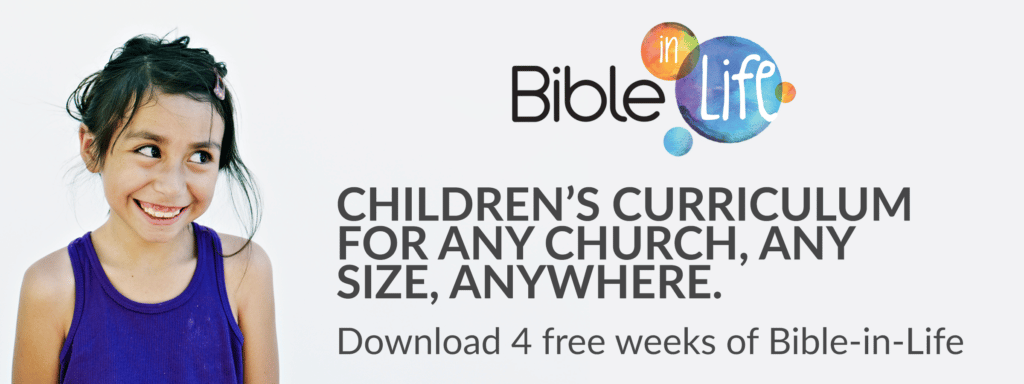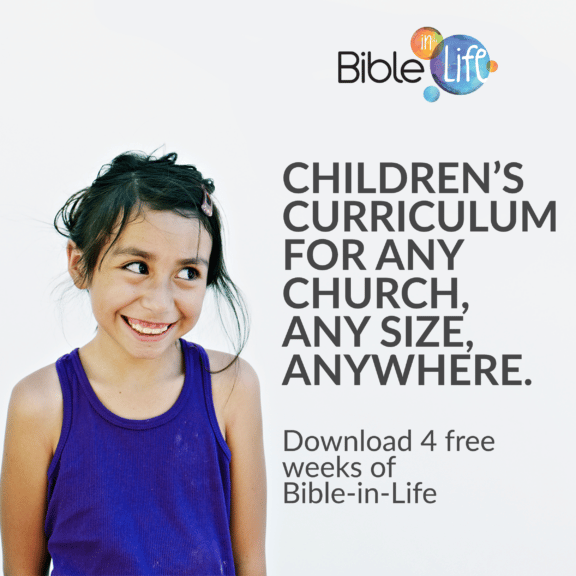THE BASICS FOR LEADERS
Moses had a good run going. Following God’s instructions, he’d managed to pry hundreds of thousands of his people out of Pharaoh’s grasp. They’d left Egypt. Found a way to get organized and stay together on the long march.
But now here Moses was: the Red Sea in front of him, an Egyptian army behind him, and the people in a panic. What should they do, the people wanted to know. What was the plan?
Here’s the truth: Moses didn’t have a plan—but God did. A plan for that day . . . the next day . . . all the way to the promised land. Moses discovered again that he could trust God, that faithfully following God’s plan was what God required of Moses. And that while Moses might not know what to do next, God had a plan for Moses—and God has a plan for us too!
OPENING ACTIVITY
Option 1: Howzitgoing’

Supplies
- Pencils
- Prepared poster
Before kids arrive, draw a line on a poster. Place a 1 on the left end of the line, a 10 on the right, and a 5 in the middle. As kids arrive, ask them to pencil in their initials on the line.
Say: If this past week was so awful you wish you’d slept through it, place your initials by the 1. If it was a great week you wish you could repeat, put your initials by the 10. Place your initials anywhere on the line that shows how you feel about this past week–except exactly on the 5. That’s because there’s no such thing as a week that’s exactly half good and half bad!
After kids have signed in, give them 30 seconds each to explain why they placed their initials where they did. Be sure to include your own initials and explain your placement on the line. Kids will begin to express themselves more over time—and hearing their stories will help you adapt this lesson to make it relevant to your kids’ lives
Option 2: According to Plan
Supplies
- Paper
- Safety scissors (several)
Give each child a sheet of paper and a pair of safety scissors.
Show children how to turn the paper sideways (landscape position) and make two cuts that go almost to the top of the paper (see diagram). If you don’t have enough safety scissors for each child to have a pair, let children take turns. (Invite older kids to help younger ones do the cutting if needed.)

Say: Hold your papers on the sides. When I say “go,” pull on both sides, ripping the paper so the middle section falls straight down. Ready? Go!
As children tear the papers, they’ll notice that the center sections don’t flutter straight to the floor. Give children a chance to try again with new sheets of paper, if desired.
Say: Good plan, but it didn’t work. Why do you think that’s true?
Take suggestions. If they aren’t mentioned, add these reasons: it’s hard to pull both sides precisely the same and the cuts probably aren’t identical.
Say: We often come up with great plans that don’t work out. Find a partner and describe a plan of yours that sounded great, but bombed. Or share another plan you know of that didn’t work out.
Allow time for partners to share. Then say: Today we’ll explore what Moses discovered about God’s plans.


GAME FOR A BAD DAY
Button It Up
Supplies
- 1 adult-size button-up shirt for every 2 kids
Invite children to find partners. Ask the child in each pair whose birthday is closest to Christmas to close his or her eyes. Hand the other child in each pair an unbuttoned shirt.
Have the children with their eyes closed describe to their partners how to put on the shirt and button it up. Here’s the catch: the person with eyes open in each pair must do exactly what’s said—and only what’s said.
After two minutes, have children giving instructions open their eyes and see how their instructions worked out. Then have partners switch roles and repeat the activity.
Retrieve the shirts and say: Sometimes our directions don’t always make sense—even if we plan to do something simple like buttoning up a shirt. But God’s directions and plans are perfect, even if we don’t always understand why he’s asking us to do something.
BAD DAY BIBLE STORY
Moses Jigsaw
Supplies
- 3 Bibles
Form your children into three groups. Give each group a Bible and help groups find Exodus 14. (A group could be one child, and if necessary, you can be a group.) If you have non-readers or younger kids, pair them with older kids who can read to them.
Explain that you’ll give each group a passage to read and act out in private. Tell kids they will have a chance to act out their passages for the whole group in a few minutes. Assign one of the following passages to each group. Allow several minutes for groups to read and prepare, checking in to see that everyone understands what he or she is reading.
Group 1: Exodus 14:5-14
Group 2: Exodus 14:15-22
Group 3: Exodus 14:23-31
After groups present their portions of Moses’ story in order, discuss the following as a larger group:
- Was it fair that God didn’t share his whole plan with Moses? Why or why not?
- Does it seem fair that God hasn’t told you what he has planned for all of your life? Why or why not?
Say: God doesn’t give us all the details about what will happen to us. But God has a plan for everything and everyone–and he knows you and will be with you forever.
Close the activity by reading aloud Matthew 10:29-31 and John 11:25, 26a. Remind kids that God has a plan for us all.
CLOSING PRAYER
Popcorn Prayer
Have children sit on the floor in a circle.
Say: Let’s offer God one-word prayers today. Think of a word that says how you feel about knowing God has a plan for your life. Maybe that word is comforting because you feel loved knowing God cares for you and your future. Maybe that word is afraid because you think you won’t be able to do what God has for you to do. Think of your own word now.
I’ll open our prayer. When you have a word in mind, pop up to your feet, say it out loud, and then sit again. I’ll close for us.
Participate yourself by offering a word. Begin simply with, “Dear God, please hear our prayer” and end with a simple “In Jesus’ name, amen.”
EXTRA-TIME ACTIVITY

Option 1: Fingerprint
Supplies
- 1 sheet of paper and pencil per child
- A box of facial tissues or damp paper towels
- Saucers
- Tempera paint or water-based highlighters (not yellow)
- Newspapers
Cover a table with newspapers. Pour a bit of tempera paint in a saucer and place it on the newspaper. Give each child a sheet of paper. (If you don’t have paints, simply use a colored, water-based highlighter to “paint” each child’s thumb or finger pad and make a print on his or her sheet of paper.)
Invite kids to dip their thumb or finger pads into the paint and stamp the prints on the paper. Wipe off excess paint with a facial tissue or damp paper towels.
Have children compare their fingerprints or thumbprints, looking closely at the patterns of swirls. Remind children their fingerprints are unique; no two are quite the same.
Give children pencils and encourage them to draw a picture of themselves, somehow incorporating their fingerprints or thumbprints as an element in their photos. For example, the print could be a head or a tummy or even a flower beside their self-portraits.
After children show each other their self-portraits, continue speaking. Say: God’s plans for us are like our fingerprints—all are the same in some ways, but all are a bit different. But one thing we’re sure of: God does have a plan for us, and as we follow Jesus, we’ll discover what it is!
Option 2: Sock Rotation
Supplies
- 3 rolled-up socks per child
Give each child at least three rolled-up socks. Explain that juggling is actually easy—you just plan how to throw several socks in the air in rotation so you can keep them up and moving. The plan is easy.
Challenge kids to plan how they will juggle the socks; then see how the plans go.
If you have a juggler in your group, ask for a group tutoring session. It will help your juggler feel special and send everyone home with a new skill.
After attempting juggling, have children circle up and discuss:
- What does it take for a plan to work?
- What’s a plan you have for your life?
- What do you think God has planned for you?
Option 3: Inquiring Minds Want to Know
Gather kids in a circle. Ask: Plan your perfect day. What would you do? Where would you go? Who would you be with? If God were planning a perfect day for you, what would it include?
For more fun lessons like this one check out this post!









